I’ve had a Roubo-style workbench at the top of my to-do list for several years now. In fact, three years ago I helped a friend mill several large trees that they had taken down, and in return, he was nice enough to give me a bunch of really nice, thick lumber to use for a workbench (you can see it in the background of several photos). So while it finishes drying, I thought I’d build a bench from construction-grade lumber and experiment with some design ideas that I’ve seen over the years.
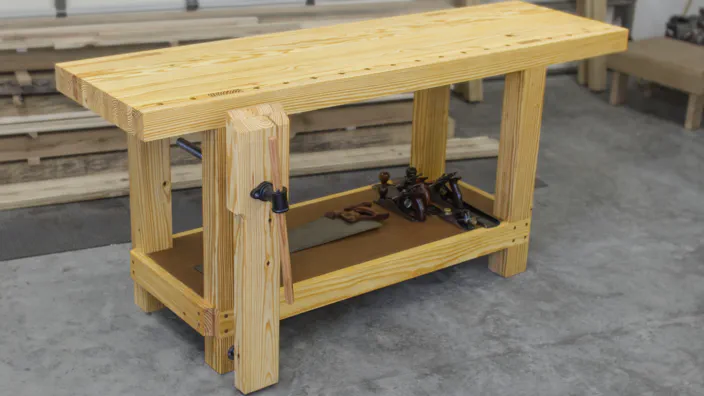
The upside to using construction grade lumber is the price. The southern yellow pine boards for this bench cost right around $100 here in North Carolina. Unfortunately, the downside to using this type of lumber is the quality. I spent quite a while sorting through lumber at two different stores to find the boards needed for this project.
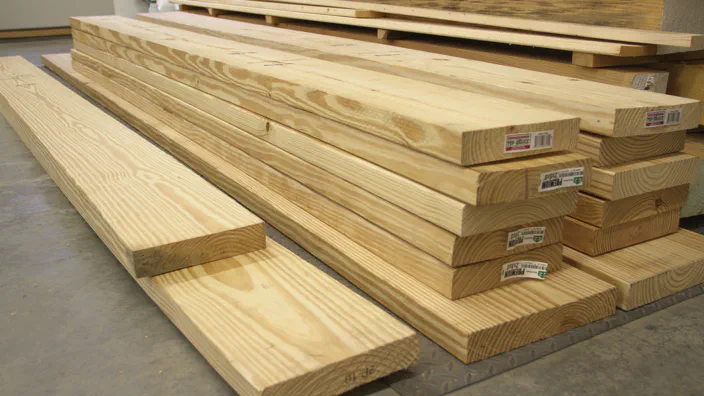
I tried to find the straightest boards without knots on either the outside edges or down the middle since they’ll all be ripped in half. A few small knots on the top are fine and can easily be filled with epoxy or Super Glue, but avoid anything big that looks like it might break off.
For the top and stretchers, I decided to use 2x8 boards which saves a little money and still results in a plenty-thick top at 3-1/4" thick and stretchers that were 3-3/4" thick. For the legs, I switched to 2x10s and ended up with legs that were a little over 4" wide.
Laminating the Top
I started with the top and split it into three sections. Trying to glue more than six long boards at a time can be stressful, and I had dreams of running the sections back through the jointer and planer.

I started with the middle section first by cutting the board to rough length at the miter saw, leaving three to four inches extra for planer snipe and for spacers. Then I joined one face and edge at the jointer and ran them through the planer to get a final thickness of 1-1/4".

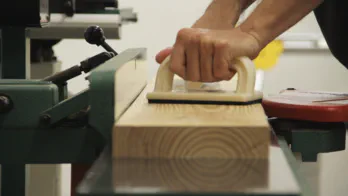
Next, I ripped the boards into two pieces by running the jointed and then newly cut edges against the fence at the table saw. I also went ahead and cut off two spacer pieces to use when laminating the legs.
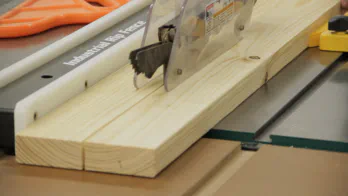
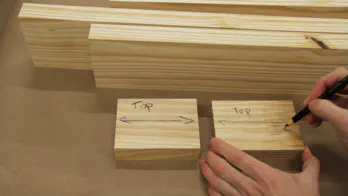
Since these boards like to warp after they’re surfaced, I also made a few cauls from some scraps. These will be used to remove any crook in the boards during glue-up by clamping them across the top and bottom edges of the boards.
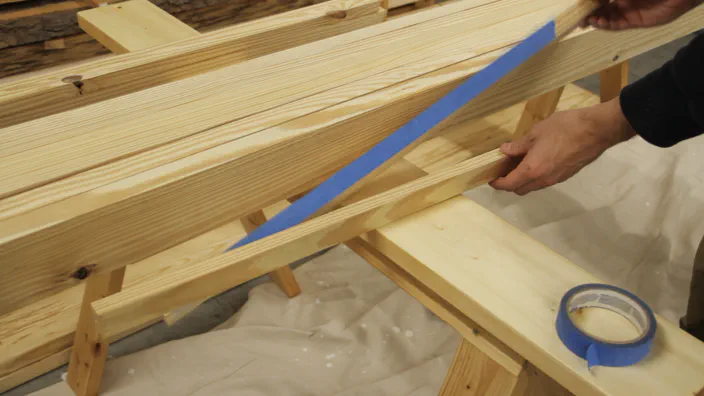
Then it was time to add some glue! For this project I used Titebond III glue which costs a little bit more but has a longer open time which reduces some of the glue-up stress. This project and the vises should take around 2/3 of a gallon, so I definitely recommend buying a gallon bottle to save some money.

I tried to move quickly and spread the glue using a hard rubber roller which worked really well. Once the glue was applied I attached the cauls and then the rest of the clamps. Then I tried to clean up as much glue squeeze-out as possible before moving on to the next two sections.
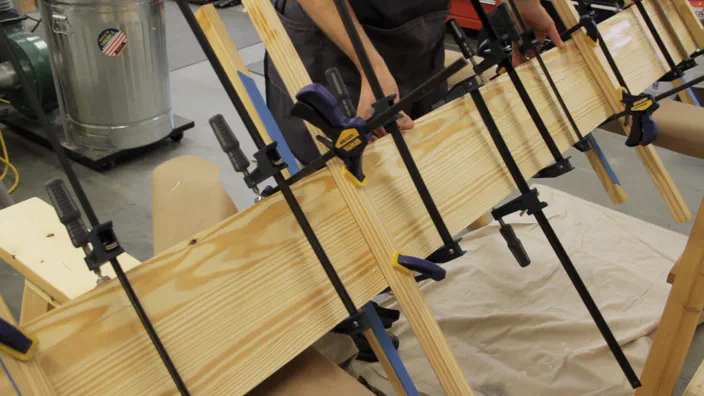
While the middle section dried, I repeated the same steps for the front and back sections except for the top’s two outermost boards. These boards will be laminated later (once spacers are made from the legs) to create the through-mortise for the legs. This avoids having to chisel the mortise holes and results in a very nice fitting joint. The important thing to remember is that the thickness of these two boards needs to match the thickness of the middle and outer leg boards and the long stretcher.


Stretchers and Legs
Next, I rough cut a single 10’ 2x8 board for the long stretchers, again leaving enough room for a 4" spacer to use when laminating the lap-joint in the legs. Note that the spacer (shown here) should be cut after the stretchers have been surfaced and ripped to final width.
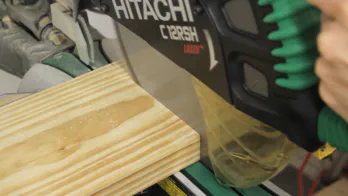

I also went ahead and cut the boards for the legs to rough length at the miter saw also leaving about 4" extra for the spacer that will be used to create the mortises in the top. Since the 2x10’s that I wanted to use for the legs were wider than my jointer, I ripped them initially using my bandsaw. I then surfaced them at the jointer and planer and ripped everything to final width at the table saw.
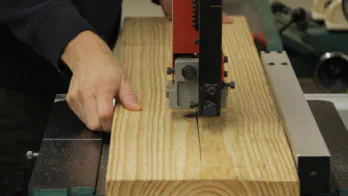
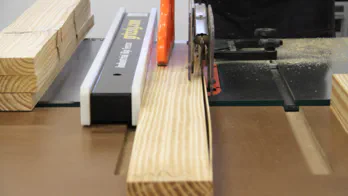
After cleaning up the top edge of the leg boards at the miter saw, it was time to glue the parts together. Each leg consists of three boards laminated together. To create the tenons on the leg, I temporarily clamped two of the spacer blocks that I cut earlier from the top to the middle leg board.
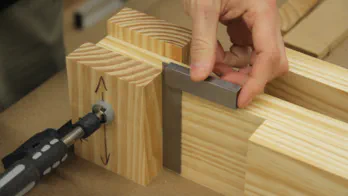
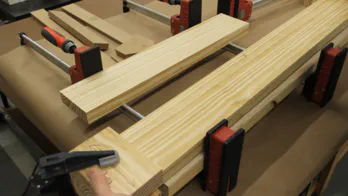
To avoid having to use a dado blade later, I also cut the front board of the leg and used the spacer cut from the long stretcher to create a lap joint.

I used a pair of parallel clamps as cauls to remove any slight warping and then came back with more clamps to complete the glue-up. Once the clamps were in place I immediately removed the spacer blocks and cleaned up any glue squeeze-out.
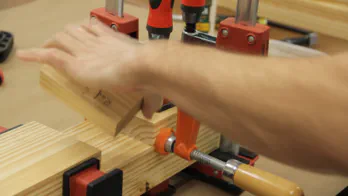

I did end up with a very small gap between two of the boards in one leg. To fix this, I made a simple filler from some pine sawdust and glue mixed together.

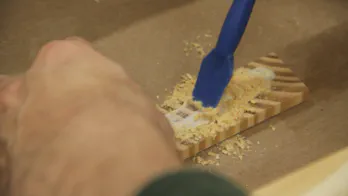
After it dried I sanded it down and cut the legs to final length at the miter saw. The odd shaped cut-offs are what I actually ended up using as spacers later for the mortises in the top.
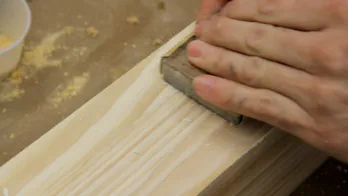
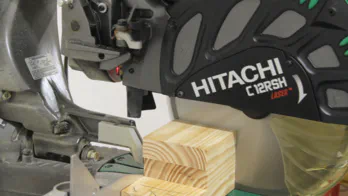
Leg Vise Preparation
Before moving back to the top, I went ahead and drilled a few holes for the linear bearing and leg vise screw at the drill press. I’ll cover this and building the chop for the leg vise in more detail in our next article.
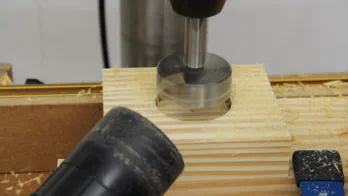

Completing the Top
To finish up the top sections, I started by cutting the left end of each laminated section at the miter saw. I then cut the boards that make up the row with the mortise into the pieces.


To make sure that the matching front and back pieces were identical, I made one final cut at the miter saw trimming each pair of boards together.

Before gluing these into place, I went ahead and drilled 3/4" dog holes as deep as I could with my Forstner bit at the drill press. This made it much easier to finish drilling the holes later with a regular spade bit.

Next, working from left to right, I glued up the three pieces to form the two mortises using the spacer blocks from the legs. And again, as soon as everything was clamped down I made sure to remove the spacers and clean up any excess glue.
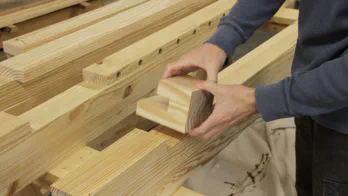
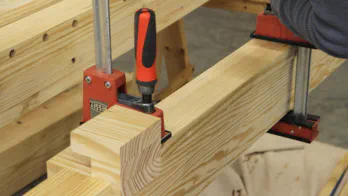
After the glue dried, I finished up the section by gluing on the outer most board. I then repeated the same steps to finish the last section.
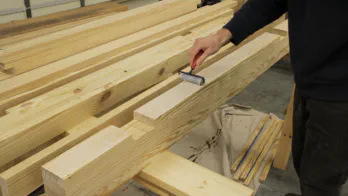

I then moved to the floor and started cleaning up the bottom of each section by sanding any glue squeeze out before switching to the hand planes to roughly flatten the sections. I had originally intended to run each of these sections back through the jointer and planer, but they were starting to get pretty heavy and my middle section actually ended up a little wider than my jointer.


While planing, I tried to focus on the area around the mortise to try to avoid any gaps once the legs were added. I also checked periodically to make sure the sides and bottom remained square.
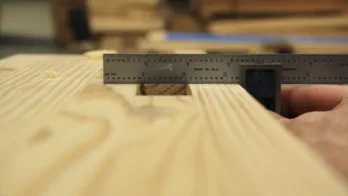
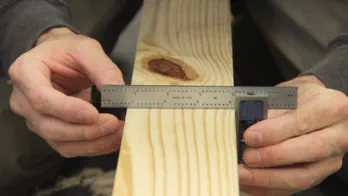
Once I was happy with the fit between the sections, I took them to the miter saw and cut them to final length which ended up being right at 6'6".

Then it was finally time to glue up the three section to form the top. I glued the rear and the middle sections together first and once those dried, I glued the front section onto the other two.
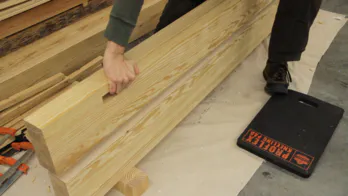
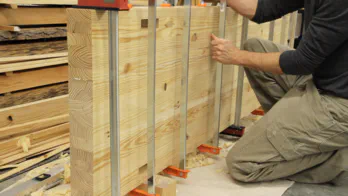
Attaching the Legs and Stretchers
Before moving onto the legs and stretchers, I routed a groove on the bottom of the top along the front for a board jack or sliding deadman which I’ll be adding in a future video.

Since assembling the entire base and then trying to get all four tenons to fit in the top at once didn’t sound like a lot of fun, I decided to fit each leg first and then attach the stretchers to them in-place.
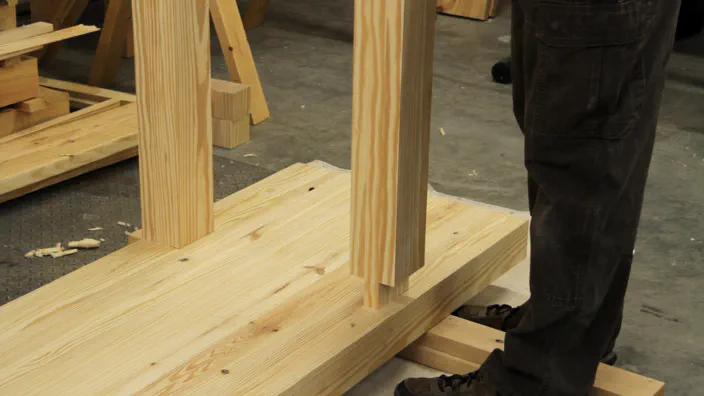
This actually went a lot better than I thought it would. After a little sanding, the tenons fit nicely, though I should have sanded one a little more as the fit was a bit tight when dry. When the glue was applied later, it required a fair amount of persuasion to fully seat.
Once all the legs were dry fit in place, I marked and cut pieces for what would later become the inner half of the short stretchers. I could then clamp one in place as a spacer and mark the exact length on the outer half of the stretcher.

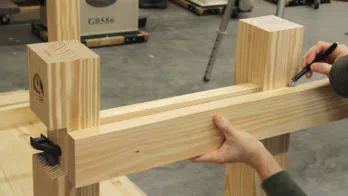
After cutting the outer boards to length, I headed over to the table saw and cut a small bevel on the ends just to make it look a bit nicer.
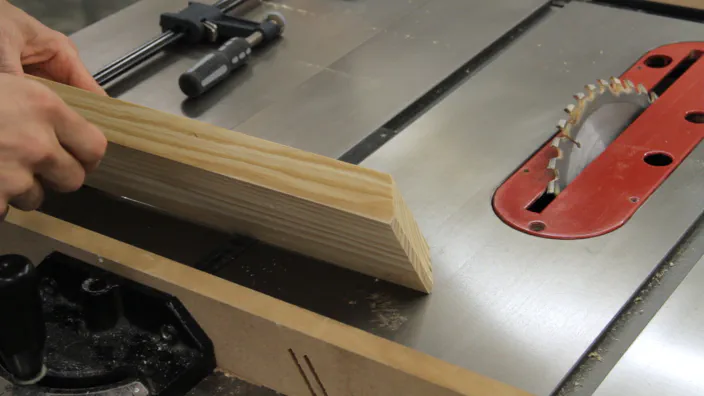
I then took them to the drill press and counterbored two holes on each side. And after clamping them back into place on the legs, I pre-drilled and screwed them into place temporarily just to make the final glue-up go faster.
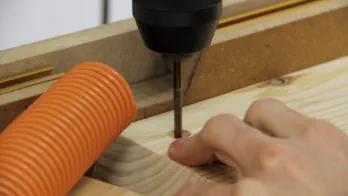
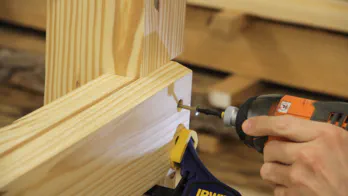
Next, I repeated the same process with the long stretchers. Starting again with the inner half and using it as a spacer to help mark the outer half.

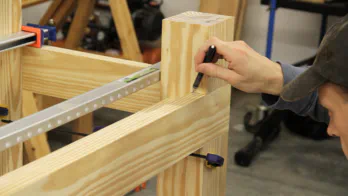
For the long stretchers I made four counterbored holes for each lap joint and again pre-drilled and temporarily screwed the stretchers in-place.
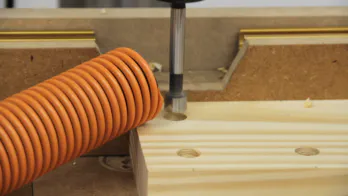
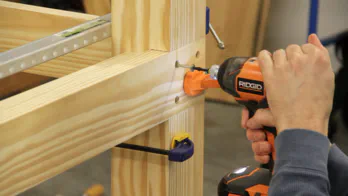
Once that was finished, I removed both of the long stretchers and then the legs and short stretchers on the right end to prepare for the first step of this glue-up.

I started the final assembly by applying glue to the mortises and tenons on the right two legs first.

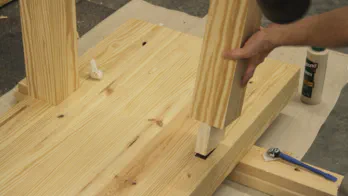
Once the legs were in place, I then glued and screwed the outer half of the right stretcher onto the legs.
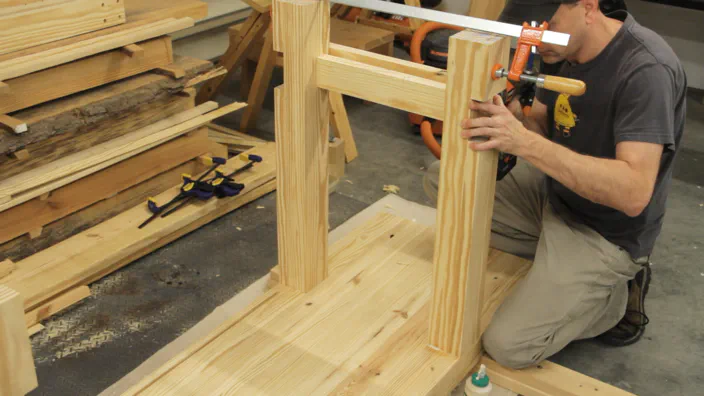
To keep the legs in their proper alignment while the glue dried, I screwed the long stretchers back into place. This also gave me something to clamp the legs down to as I didn’t have a pair of clamps that were quite long enough to go over the entire leg.
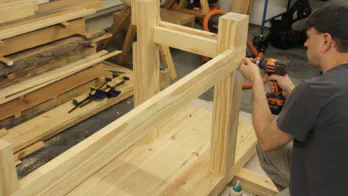

After the glue dried I repeated these same steps for the left two legs and stretchers except that I went ahead and glued and screwed the long stretchers to the legs as well.
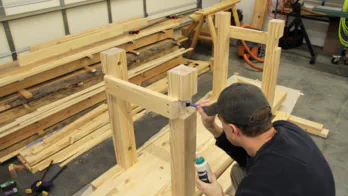

I then eased the edges of the legs and stretchers a bit with a block plane and sandpaper. I also beveled the bottom of all the feet to help prevent tear-out when the bench is moved around on the floor.

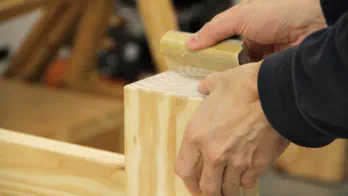
Next, I applied a little boiled linseed oil to the bottom of the top before flipping it over with the help of a friend.
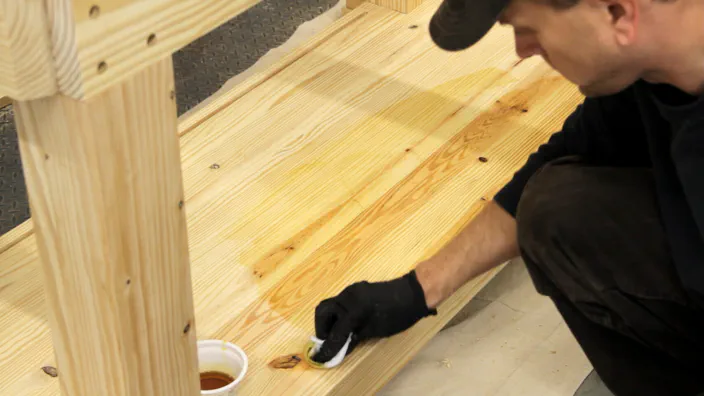
I then finished up the inside half of the stretchers by applying some glue and clamping it into place using a small piece of 3/4" MDF to position it so that the final shelf would sit flush with the outer half of the stretcher.

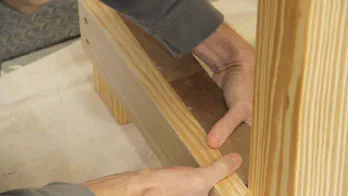
Then I screwed it into place and repeated the process for the remaining stretchers.
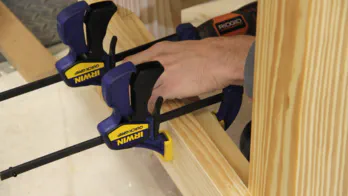

Once that was done, I marked and cut the final “inner-inner” stretchers for the left and right sides. This isn’t really needed, but I had some leftover pieces so I thought I might as well add. Note that if you are adding the leg vise it is best to hold off attaching these and the shelf until after attaching a guide board that will be described in that article. (Or just use screws and not glue for now.)
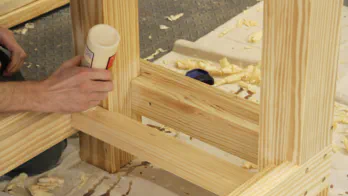
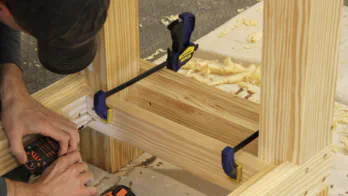
To finish up with the stretchers, I cut some 1/2" poplar dowels into plugs at the bandsaw. After gluing them into place I sanded them flush and wiped on more boiled linseed oil.
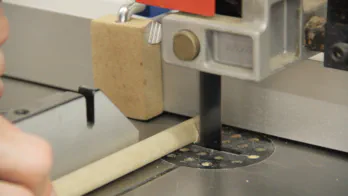

Finishing the Top
The next big step was to flatten the bench top, though it was basically just a repeat of what I did for its underside. I started by using my Stanley #5 plane to knock down most of the high spots. Rubbing some paraffin wax on the plane’s sole helped quite a bit (you can also find it at Walmart or grocery stores in their canning section).
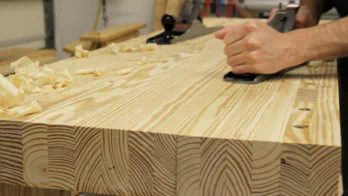
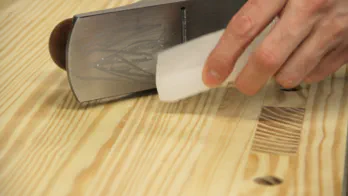
After a while, I switched to my Stanley #7 and just used my longest straight edge at different angles to check which areas needed more work. If you have a pair of winding sticks (or two straight edges) you could also check for twist. I’ll probably give mine a few more months and then double check it.

Once I was happy with the top’s flatness (completely unrelated to how tired I got), I started drilling out the remainder of the dog holes. To prevent tear out on the underside, I clamped a small board in place before using a spade bit to finish drilling the holes.
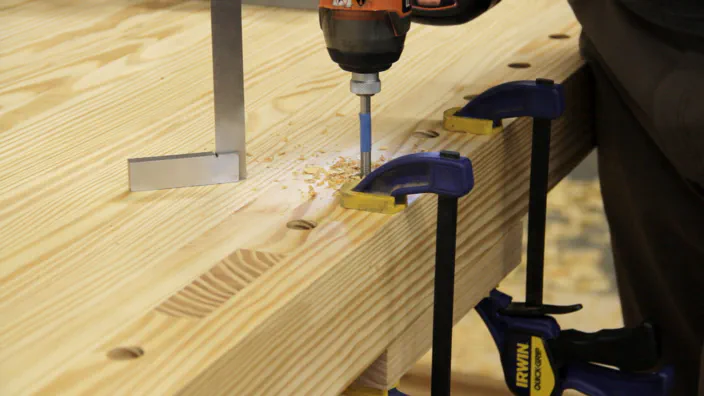
To finish the top, I sanded it with 80 grit sandpaper and eased over the dog hole edges a little before applying a coat of boiled linseed oil.
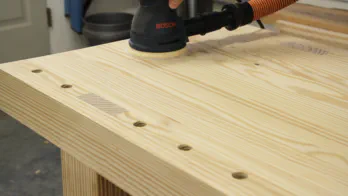
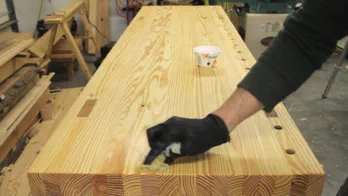
The Shelf
To finish up the bench, I measured and cut a piece of 3/4" MDF to size for the shelf (I have lots of MDF lying around). I then used a jigsaw to cut out notches in the corners to fit around the legs.

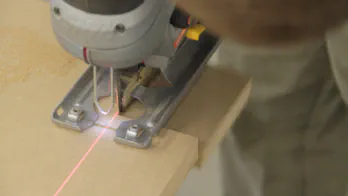
After a little test-fitting, I wiped on some boiled linseed oil which darkens the MDF. Once that dried I applied a light coat of paste wax and fit it in place on the bench.
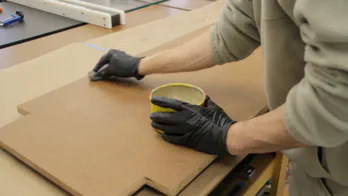

Workbench Complete (Mostly)
Well, that completes the workbench itself. So far I’m very happy with the way it turned out — especially how nice the mortise and tenon joints ended up. In the next few articles, I’ll cover the leg vise and sliding dead-man builds and then install an end vise. I’ll also be adding on a set of Quick Release Plates to share a set of Workbench Casters that I installed on my outfeed table previously.
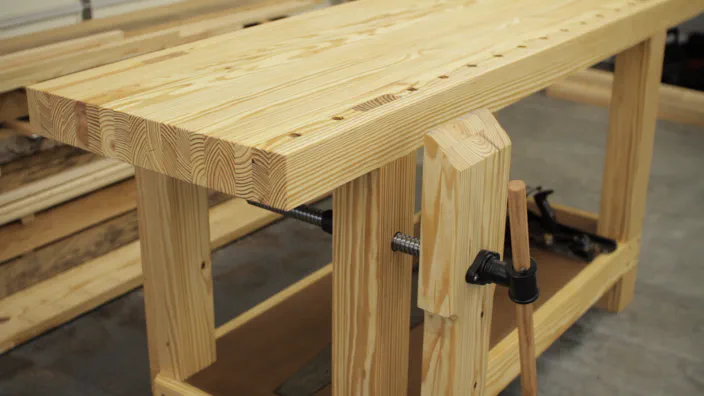
Tools & Items Used
Be sure to check out Our Workshop page for more details!
Lumber:
- Top: (9) 2"x8"x8’ Southern Yellow Pine Boards
- Stretchers: (1) 2"x8"x10’ and (1) 2"x8"x8’ Southern Yellow Pine Boards
- Legs: (2) 2"x10"x10’ Southern Yellow Pine Boards
- Leg Vise Chop: (1) 2"x8"x8’ Southern Yellow Pine Board
Leg Vise:
- Yost Tools 18" Vise Screw
- 20mm Linear Motion Bearing
- 20mm Rod - Select 20mm/251-500mm and Customize to 400mm for a 16" rod.
- 20mm Forstner Bit
Tools:
- Hitachi 12" Compound Sliding Miter Saw (C12RSH) - Latest version now sold by Metabo: C12RSH2S
- Dewalt Heavy Duty Miter Saw Stand (DWX723)
- Grizzly 8" Jointer (G0586) on Mobile Base
- Ridgid 13" 3-Blade Thickness Planer (R4330) ( Latest version: R4331)
- Grizzly 17" Bandsaw (G0513P)
- Grizzly G0691 Table Saw
- Craftsman 17" Drill Press (22901) on Mobile Base
- Drill Press Table
- Bosch 5" Random Orbit Sander (ROS20VSC)
- Skil 6 Amp Scrolling Jigsaw (4690-01)
- Rockler 16-Piece Forstner Drill Bit Set
Plans
We did a pair of SketchUp and Fusion 360 tutorials covering the design of this bench which include completed files for both.
Questions and Answers
I thought I’d add a section here for common questions and answers that people might have. If you have any additional questions, be sure to leave a comment below.
Why this style of workbench? It’s relatively simple to make and there are a lot of work clamping options. See Christopher Schwarz’s books Workbenches: From Design & Theory to Construction & Use and The Workbench Design Book for a bigger list of what to look for in a workbench as well as several other workbench designs.
What type of wood? Construction-grade 2x8 and 2x10 southern yellow pine.
What did the lumber cost? Around $100 here in NC.
Which type of glue / how much glue? Titebond III for the longer open time. A gallon bottle is much cheaper than individual bottles. I used a bit less than 2/3 of a gallon for the bench and vises.
What screw did you use for the leg vise? Yost 18" Vise Screw
What end vise did you use? Rockler End Vise
Final size and weight? 6'6" Long, 22.5" Deep, 35.4" High. The top ended up being 3-1/4" thick. The bench with the shelf weighs roughly 220 pounds. The leg vise adds about 13 pounds, and the end vise adds close to 40.
What spacing between dog holes did you use? 4", roughly 6.5" around the leg tenons
Do I need a jointer? With nice looking (or pre-surfaced) boards, a planer can likely be used to skip-plane the boards and avoid a jointer.
Do I need a planer? It certainly helps to ensure that the outer two boards are the same thickness. It’s certainly possible to do by hand though these (or all) boards could be purchased pre-surfaced – basically trading the cheaper construction lumber for the cost of the planer and joiner.
Do I need a 12" sliding compound miter saw? It speeds up cutting the long laminated sections to length. This could be done with a circular saw and/or a hand saw though. The smaller pieces can definitely be crosscut at the table saw or with a circular saw.
Do all boards need to be the same thickness? No. The thickness of the top’s mortise-row boards needs to match the middle board of the leg which makes the tenon. And the top’s front and back boards need to match the front board of the legs and long stretchers. I actually left the middle boards in the top as thick as possible, which is why that section would not fit on my jointer after glue-up.
Any board selection tips?
- Avoid 2x4 and 2x6 construction grade lumber if possible. Around here, southern yellow pine boards start in 2x8 widths.
- Avoid boards with knots that are near either the outer edges or center. This will give you one good edge when the wider board is ripped in half.
- For a more consistent looking top, check the grain pattern on the edges of the board and avoid ones with a cathedral pattern if possible.
- Check multiple stores if possible. I went to two stores to get the 15 boards for the bench.


